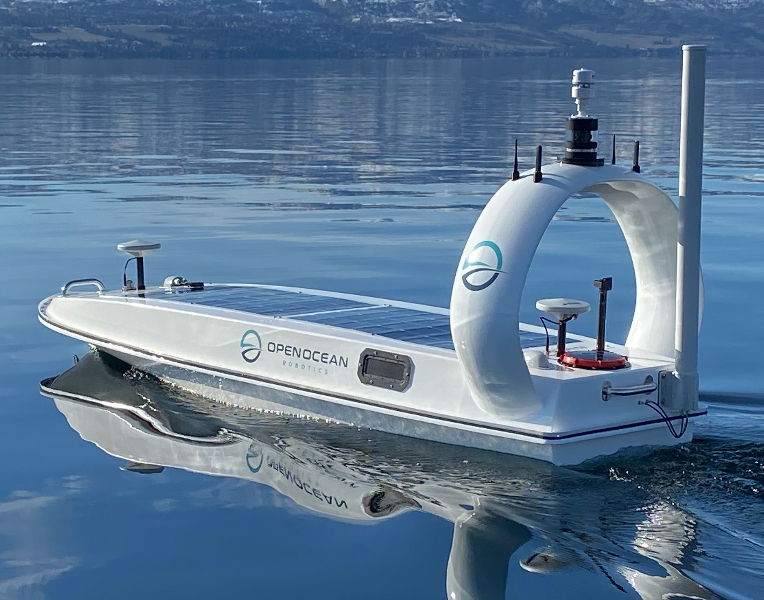An Industrial Revolution at Sea
An industrial revolution is happening on the high seas. Combine robotics, AI, low-cost sensors, satellite systems, big data, biotechnology and genomics, and you get rapid and disruptive change across the marine industries - change that is opening up whole new sectors of ocean use and research.
And that’s exciting because many of these disruptive marine technologies are helping us sail toward a cleaner and safer future for our oceans.
One of the companies in this mix is Open Ocean Robotics headquartered in Victoria, BC.
Open Ocean Robotics designs and manufactures wind and solar powered autonomous boats that collect real time data - information that can help us understand and map one of the most mysterious regions of our planet - the ocean.
Transforming Ocean Research
The information that can come out of these autonomous, non-polluting boats is what Julie Angus, CEO of Open Ocean Robotics believes can transform how research is done on the ocean:
“The ocean can be a harsh and costly environment to work and study in, with autonomous, un-crewed drones, we can improve safety and reduce costs while gathering excellent research data.”
Non-Polluting, Powered by Solar and Hurricane Proof
The Open Ocean robotic boats not only don’t require any operators on board - they are self-righting, rigid and extremely durable. Angus says they will not only right themselves, but would continue to run even in hurricane type conditions. And since they are powered entirely on solar, there are no GHG emissions, no noise pollution, and no potential for oil spills.

Next Steps: From Prototype, To Pilot Project, to Production
Being an innovator on the high seas and spearheading a marine-based industrial revolution is not easy.
But, if there is a north star to steer by in her business, Angus credits Foresight’s EiR Kirk Hamilton and the Foresight Launch Program with being that guiding light for her business in its initial stages.
"Kirk has exceptional expertise in building a business, in knowing how to set milestones and build the structures required to grow the business. That’s been invaluable for me as a technical founder.”
Pilot Project – Mapping Lake Okanagan
Open Ocean Robotics are currently conducting a pilot project with the Canadian Coast Guard & the Dept of Fisheries and Oceans to map Lake Okanagan, a large fjord lake in the Okanagan Valley in British Columbia (where they are sure to find Ogopogo, but that’s another story
Although Lake Okanagan is an inland lake, it’s worth noting that there is a global initiative to map the entire sea floor by 2030, and as seaworthy vessels, Open Ocean’s robots are poised to be active in this market as well.
(And Canada has a long way to go on mapping the sea floor – only 1% of the Canadian Arctic is fully mapped to modern standards).
Mapping Lake Okanagan is an exciting pilot project – to not only prove the economic viability of the products, but to expand what is thought to be possible in collecting and analyzing data from various waterways. The type of data the boats can collect is nearly endless. The boats
can collect information about currents, tides, temperature, salinization levels, habitat, debris, fish, wildlife, wind.
The uses and applications of the research data are also nearly endless – navigation, biological analysis, harvesting/fishing, oil spill response planning, protecting at-risk species, cracking down on illegal fishing, improving fuel efficiencies, and understanding the impacts of climate change on the oceans.

Open Ocean Robotics – a Company to Watch
Open Ocean Robotics was recently listed on the “50 Companies to Watch” list published by the Cleantech Group, and for good reason – not only do they have a solid business model and innovative technology, the research their autonomous boats enable has transformative potential. The future of the ocean is threatened on many fronts – from pollution, melting ice caps (and rising water levels), unrestrained fishing, plastics and micro-plastics, and rising temperatures. We will need smart people and solid research data to understand these threats and mitigate them.
Margaret Leinen the Director, Scripps Institution of Oceanography, at UC San Diego put it this way:
“The food and precious resources the oceans provide to global society have been bountiful, but we see them diminishing. We must act strategically going forward. It serves all of us, as a global society, to maintain the stability of the oceans as a natural system.”
The oceans are a complex natural system and the global observation and research networks that are trying to understand it all need solutions like the technology provided by Open Ocean Robotics – solutions that not only provide them with affordable, safe data collection methods, but also the breadth and scope of information they need to think strategically and problem-solve on a global level.
Open Ocean Robotics, located on the shores of the Salish Sea in beautiful British Columbia, is playing its part in a new future for the ocean.
Oceans and waterways are not just platforms for tourism and recreation and traditional industries like fishing or shipping. They are research labs and centres of learning and innovation. They are sustainable energy solutions from marine algae–derived biofuel. They are new medicines or new food products derived from sea creatures with novel chemical structures.
They are the future.
*Okanagan Lake Photo Credit : (WT-shared) Bulliver at wts wikivoyage - Own work, CC BY-SA 1.0, https://commons.wikimedia.org/w/index.php?curid=23298204



